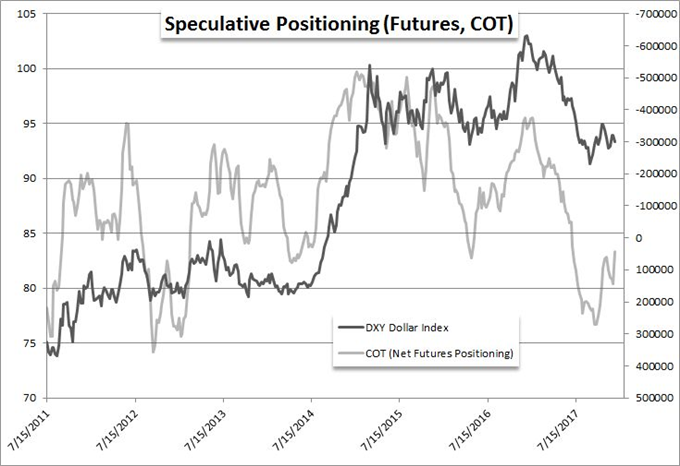Talking Points:
- A market is the reflection of the positioning of all its participants - one of the main reasons many only follow technical analysis
- There are different participants in the markets with different behaviors and influence ranging from central banks to retail traders
- I follow what the larger, more transparent interests are doing; but my trades are more shorter duration
See how retail traders are positioning in the FX majors, indices, gold and oil intraday using the DailyFX speculative positioning data on the sentiment page.
The price that we see in any market or asset reflects the cumulative view of all the participants behind it. It seems rudimentary to state that when there are more buyers than sellers, a market rises. To be more accurate, when the greatest amount of wealth is behind buyers rather than sellers, prices will rise; but the general theme is theory is accurate. This is why many technical analysis purists swear off fundamentals. If price action already reflects all that is assumed and known about a market, why complicate the matter with the 'why'? Well, if our interests were purely to explain price action, then we could abide that view. However, to assume there is a clear repeating pattern to fall back on from our memory bank (or chart) that accurate reflects where our current condition will end up presumes that nothing changes in our circumstances. They do change. But on the same hand, fundamentals do often get bound up in explanation that misses critical information, leverages the importance of something that is perhaps lacking influence or otherwise inaccurately portrays what is motivating the masses.
To understand a market's bearings, we must understand the market itself. The participants collectively decide our bearing and pace; but we can't know what everyone is doing. We can however, break the broader market down into its bigger players and perform reasonable analysis on their motivations and pressure points. In breaking a liquid market like developed world equities, currencies or US Treasuries into its major participants; we have a natural range. We can organize them from largest to smallest size for an assessment of their impact on price action and behavior often correlates to the position on that ranking. The large sets I usually look to run from (largest to smallest): central banks; large international banks; sovereign wealth funds; hedge funds; large individual traders and small retail traders (like you and me). At the high end of the curve, you have extravagant size and influence but motivation that is stoic and transparent. On the other end, there is erratic opportunism but very limited impact on the overall market.
At some point, all players on this scale will influence the market and should be taken into consideration. However, to best analyze for your trading; it is best to pay closer heed to those participants that more closely match your intended time frame. If you plan to be in a market for months or years, then look at the greater collective impact on trend that the bigger participants have. On the other hand, opportunists looking for short-lived swings in certain assets would instead track the smaller more active interests. I find myself towards the latter end of that scale when selecting trades, but I always keep tabs on the other extreme. For tools, the sentiment measure of retail traders that we follow on DailyFX offers the most inexperienced and active traders views. One step higher, we have the CFTC's Commitment of Traders report for net speculative futures exposure. Often the former is considered an absolute contrarian reading and latter always accurate. In reality, it is far from that consistent. Context is necessary for all indicators or analysis, and positioning is no different. We focus on my approach to sentiment and positioning analysis in today's Strategy Video.



To receive John’s analysis directly via email, please SIGN UP HERE





